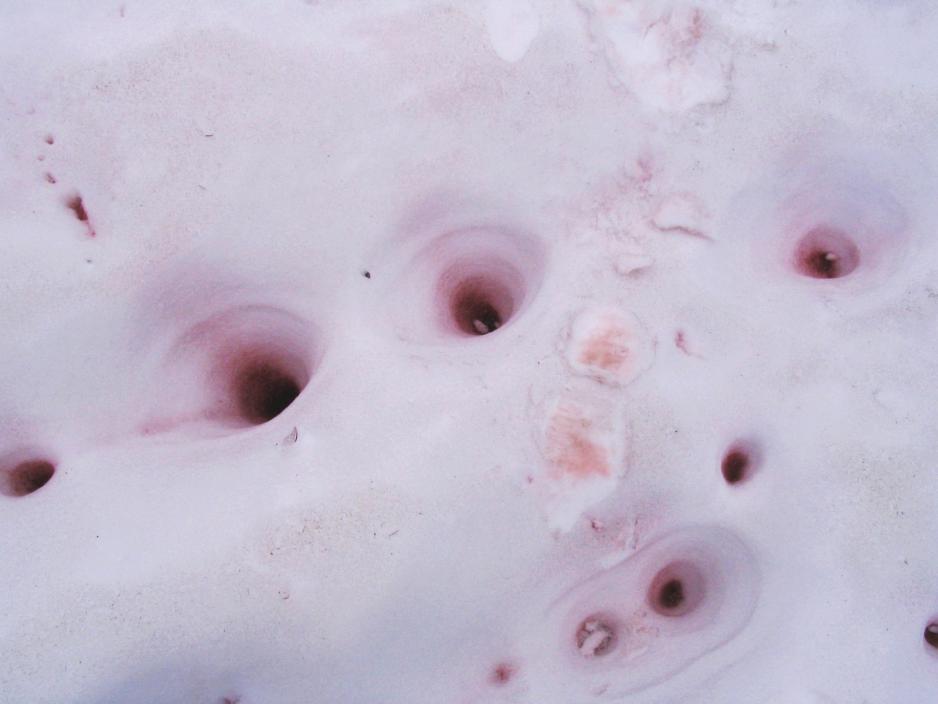Beyond the Sea Ice Melt: Red Snow, Glaciers, and Climate Models

As sea ice melt continues to break records in almost every month of 2016, there’s another dramatic melt that’s damaging northern ecosystems and changing the Earth’s climate: glacial ice and snow.
Arctic sea ice melt - its causes, challenges, and opportunities - has been the most talked about environmental change in the North since the starling images of disappearing sea ice circulated the globe in 2012. But rising air and ocean temperatures are not the only threat to a wetter future for the Arctic.
A new study in Nature Communications has brought to light another major contributor to glacial melt: watermelon snow.
Chlamydomonas nivalis, more commonly known as red, pink, or watermelon snow, is a cold loving species of green algae with red pigments. As they bloom, their red pigmentation substantially darkens the surface of glacial ice and snow. The darker color of the ice changes the amount of light reflected off its surface, melting it at a much faster rate than clean white ice.
The study “The Biogeography of Red Snow Microbiomes and Their Role in Melting Arctic Glaciers,” conducted by a team of seven researchers led by Stephanie Lutz of the University of Leeds, found that watermelon snow algal blooms are decreasing the amount of light reflected by as much as 13 percent over the course of the summer melt season.
Samples from 16 glaciers
The research team took 40 watermelon snow samples from a total of 16 glaciers in Svalbard, Northern Sweden, Greenland, and Iceland between July 2013 and July 2014. Despite differences in local ecology, geography and mineralogy, the algae were found to thrive in every site.
The finding that these few species of algae are able to not only survive but colonize, thrive, and spread easily cross an ecosystem under a wide range of conditions is particularly important. It means we can expect to see a lot more red snow in the Arctic’s future.
Updating Our Climate Models
Colored snow algal blooms have been known to exist since the age of Aristotle, and yet their effect on ice melt is not included in current climate models.
“Incorporating the darkening of the snow into climate models will be important, especially in regards to local melting rates,” says Dr. Forest Rohwer, an American microbial ecologist and professor at San Diego State University. Including this “bio-albedo” effect of red snow melt into climate models would help to more accurately predict the speed and location of circumpolar glacier melting, providing more information to adapt to the wide range of environmental impacts that will follow.
Dr. Rohwer has been studying red snow in Franz Josef Land in the Russian Arctic. “Darkening of the snow and ice is one of those unfortunate positive feedback systems that exasperated the problem of increasing melting rates.”
The positive feedback loop Dr. Rohwer alludes to is dire.
The work of the algae creates a chain reaction of additional melting. The newly melted water creates new habitats for algae to colonize, and darker colored rocks and dirty ice underneath the glaciers are exposed. The more glacial ice melts from this feedback loop, the more local Arctic shorelines erode and global sea levels rise.
However, even if melting from red snow is factored into current climate models. Dr. Rohwer argues that this may not lead to any mitigation of the problem. “As with most biological phenomena, there is very little we can do to control them on large scales. That is, the exponential nature of these dynamics means that there isn't an apparent engineering fix. Once we understand the underlying mechanics, however, there maybe ways to manipulate the system.”
Beyond Rising Tides
Rising sea levels are not the only consequence of more algae blooms in the Arctic. According to Dr. Rohwer, “another unfortunate consequence is the increased runoff of organic carbon-enriched freshwater into the seawater. This increases microbial activity is predicted to increase CO2 release from the surrounding ocean.”
He also warns of seeing more bird and animal die-offs in the Arctic. “Our work strongly suggests that there is also a major increase in potential pathogens, which may partially explain the increased die offs of birds and mammals in the polar regions.”
As Crystal Cruise liner Serenity takes advantage of retreating sea ice this summer with its voyage through the Northwest Passage, Dr. Rohwer sees no opportunity in the algae blooms melting glacial ice. “Usually, I look for an upside. However, I don't really see anything good about the red snow and the other darkening agents.”
